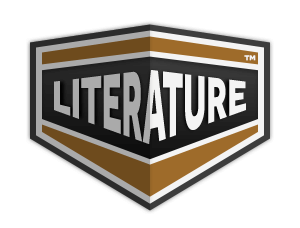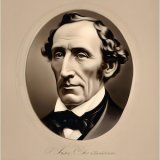Little Tiny or Thumbelina Page #2
In "Little Tiny or Thumbelina," author Hans Christian Andersen introduces readers to Tiny, a lovely girl no bigger than a thumb. She is brought into the world inside a barleycorn given to a woman by a witch. Thumbelina's adventures begin when she is kidnapped from her cozy home by an ugly toad, desiring her as a bride for her son. Thumbelina's journey takes her to many unknown, dangerous places, filled with monstrous creatures. Despite her trials, Thumbelina never loses her courage, for she is a kind-hearted creature. The tale underscores the classic theme of good triumphing over evil, ending with Thumbelina's reunion with loving, beautiful creatures just like her.
Genre: Children
Genre: Children
- 31 Views
trouble himself at all about the matter. He seated himself by her side on a large green leaf, gave her some honey from the flowers to eat, and told her she was very pretty, though not in the least like a cockchafer. After a time, all the cockchafers turned up their feelers, and said, "She has only two legs! how ugly that looks." "She has no feelers," said another. "Her waist is quite slim. Pooh! she is like a human being." "Oh! she is ugly," said all the lady cockchafers, although Tiny was very pretty. Then the cockchafer who had run away with her, believed all the others when they said she was ugly, and would have nothing more to say to her, and told her she might go where she liked. Then he flew down with her from the tree, and placed her on a daisy, and she wept at the thought that she was so ugly that even the cockchafers would have nothing to say to her. And all the while she was really the loveliest creature that one could imagine, and as tender and delicate as a beautiful rose-leaf. During the whole summer poor little Tiny lived quite alone in the wide forest. She wove herself a bed with blades of grass, and hung it up under a broad leaf, to protect herself from the rain. She sucked the honey from the flowers for food, and drank the dew from their leaves every morning. So passed away the summer and the autumn, and then came the winter,--the long, cold winter. All the birds who had sung to her so sweetly were flown away, and the trees and the flowers had withered. The large clover leaf under the shelter of which she had lived, was now rolled together and shrivelled up, nothing remained but a yellow withered stalk. She felt dreadfully cold, for her clothes were torn, and she was herself so frail and delicate, that poor little Tiny was nearly frozen to death. It began to snow too; and the snow-flakes, as they fell upon her, were like a whole shovelful falling upon one of us, for we are tall, but she was only an inch high. Then she wrapped herself up in a dry leaf, but it cracked in the middle and could not keep her warm, and she shivered with cold. Near the wood in which she had been living lay a corn-field, but the corn had been cut a long time; nothing remained but the bare dry stubble standing up out of the frozen ground. It was to her like struggling through a large wood. Oh! how she shivered with the cold. She came at last to the door of a field-mouse, who had a little den under the corn-stubble. There dwelt the field-mouse in warmth and comfort, with a whole roomful of corn, a kitchen, and a beautiful dining room. Poor little Tiny stood before the door just like a little beggar-girl, and begged for a small piece of barley-corn, for she had been without a morsel to eat for two days. "You poor little creature," said the field-mouse, who was really a good old field-mouse, "come into my warm room and dine with me." She was very pleased with Tiny, so she said, "You are quite welcome to stay with me all the winter, if you like; but you must keep my rooms
Translation
Translate and read this book in other languages:
Select another language:
- - Select -
- 简体中文 (Chinese - Simplified)
- 繁體中文 (Chinese - Traditional)
- Español (Spanish)
- Esperanto (Esperanto)
- 日本語 (Japanese)
- Português (Portuguese)
- Deutsch (German)
- العربية (Arabic)
- Français (French)
- Русский (Russian)
- ಕನ್ನಡ (Kannada)
- 한국어 (Korean)
- עברית (Hebrew)
- Gaeilge (Irish)
- Українська (Ukrainian)
- اردو (Urdu)
- Magyar (Hungarian)
- मानक हिन्दी (Hindi)
- Indonesia (Indonesian)
- Italiano (Italian)
- தமிழ் (Tamil)
- Türkçe (Turkish)
- తెలుగు (Telugu)
- ภาษาไทย (Thai)
- Tiếng Việt (Vietnamese)
- Čeština (Czech)
- Polski (Polish)
- Bahasa Indonesia (Indonesian)
- Românește (Romanian)
- Nederlands (Dutch)
- Ελληνικά (Greek)
- Latinum (Latin)
- Svenska (Swedish)
- Dansk (Danish)
- Suomi (Finnish)
- فارسی (Persian)
- ייִדיש (Yiddish)
- հայերեն (Armenian)
- Norsk (Norwegian)
- English (English)
Citation
Use the citation below to add this book to your bibliography:
Style:MLAChicagoAPA
"Little Tiny or Thumbelina Books." Literature.com. STANDS4 LLC, 2024. Web. 20 May 2024. <https://www.literature.com/book/little_tiny_or_thumbelina_2190>.




Discuss this Little Tiny or Thumbelina book with the community:
Report Comment
We're doing our best to make sure our content is useful, accurate and safe.
If by any chance you spot an inappropriate comment while navigating through our website please use this form to let us know, and we'll take care of it shortly.
Attachment
You need to be logged in to favorite.
Log In